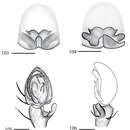Description
provided by Zookeys
Paratype male:Color: Carapace uniformly light brown; sternum pale yellow, darker around border; chelicerae uniformly light brown; maxillae dusky light orange-yellow, lightening distally; labium orange-brown, lightening toward the distal edge; abdomen dorsally yellow-brown with red-brown markings; ventrally dusky yellow-grey, no markings; legs uniform yellowish. Carapace:0.89 times longer than broad. Eyes:AER slightly recurved; PER recurved; PME larger than AME, PLE largest, ALE smallest; eye diameters, AME 0.18, ALE 0.15, PME 0.30, PLE 0.43; interdistances AME-PME 0.05, PME-ALE 0.13, ALE-PLE 0.30. PME-PME 1.13 mm. ALE-ALE 1.95; ocular quadrangle AME-AME 0.40, PLE-PLE 2.15; clypeus 0.09 high. Mouthparts:chelicerae with a few stout setae medially and anteriorly; maxillae longer than broad, with tuft of conspicuous setae distally; labium distally rounded. Sternum:as long as broad, posteriorly indented. Legs:Leg I only slightly shorter than legs II, III and IV; leg formula 2341;scopulae present on distal end of all 4 tarsi; tarsi I-IV with strong claw tufts; pr claw per foot slightly toothed; spination: leg I, Fm pr 1–1–1, d 1–1–1, rl 1–1–1; Ti d 1–1–0, pr 1–0–1, rl 1–0–1, v 2–2–2–2; Mt pr 1–1–0, v 2–2–0, rl 1–0–0; leg II, Fm pr 1–1–1, d 1–1–1, rl 1–1–1; Ti pr 1–1–0, d 1–1–0, rl 1–1–0, v 2–2–2–2; Mt pr 1–1–0, v 2–2, rl 1–0–0; leg III, Fm pr 1–1–1, d 1–1–1, rl 1–1–1; Ti pr 1–1–0, d 0–1–0, rl 1–1–0, v 2–2–2; Mt pr 1–1–0, rl 1–1–0, v 2–2–2; leg IV, Fm pr 1–1–1, d 1–1–1, rl 1–1–1; Ti pr 1–1–0, v 2–2–0, rl 1–1–0; Mt pr 1–1–0, rl 1–1–0, v 2–2–1. Abdomen:Without terminal setal tufts. Pedipalp:Femur spination pr 0–0–1, d 0–1–2, rl 0–0–1; cymbium triangular in ventral view; conductor large, attached to center of bulb by straight, narrow stalk, pointed laterally, extending to 1 o'clock position, curving around retrolateral side; embolus bifid, one branch long, slender, sightly sinuous, other wider at base, tapering slightly toward tip, beginning at 6 o'clock, terminating at 11 o'clock; MA originating at 3 o'clock, directed distally, stout, with single stout rounded hook; RTA extends anteriorly nearly half the length of cymbium; ventral tibial apophysis is large, wide u-shaped structure in ventral view, curving inwards toward cymbium; dorsal tibial apophysis wide, curving outward quite far from the cymbium, bifid, with one extension finger-like, directed distally, the other pointed, curving dorsally (Figs 109–110).Dimensions:Total length 7.55. Carapace length 4.10, width 4.60. Sternum length 2.00, width 2.00 Abdomen length 3.45, width 2.25. Pedipalp: Fm 1.25, Pt 0.25, Ti 0.70, Ta 0.75, total 2.95. Leg I: Fm 4.25, Pt 1.30, Ti 4.25, Mt 4.40, Ta 2.25, total 16.50. Leg II: Fm 5.00, Pt 2.00, Ti 5.10, Mt 5.10, Ta 2.25, total 19.50. Leg III: Fm 5.10, Pt 2.00, Ti 3.90, Mt 5.00, Ta 2.25, total 18.30. Leg IV: Fm 4.50, Pt 1.25, Ti 4.50, Mt 4.60, Ta 2.10, total 16.95.
Holotype female:Color:carapace uniformly brown-red; sternum light yellow-brown with darker border; chelicerae uniformly brown-red; maxillae light yellow-brown, lightening to white distally; labium light brown, lightening distally; abdomen dorsally grey-tan, dark festoon pattern caudally; ventrally dusky grey with no markings; legs yellowish with annulations on femora and tibiae, darkening toward tarsus, though annulations still visible. Carapace:0.91 times longer than broad. Eyes: AER nearly straight; PER slightly recurved; PME larger than AME, PLE largest, ALE smallest; eye diameters, AME 0.35, ALE 0.20, PME 0.40, PLE 0.50; interdistances AME-PME 0.10, PME-ALE 0.40, ALE-PLE 0.35. PME-PME 1.30. ALE-ALE 2.20; ocular quadrangle AME-AME 0.50, PLE-PLE 2.02; clypeus 0.03 high. Mouthparts:Chelicerae with stout setae medially and anteriorly; maxillae longer than broad, with tuft of conspicuous setae distally; labium distally rounded. Sternum:as long as broad, posteriorly indented. Legs:Leg I only slightly shorter than legs II, III and IV; leg formula 4321; scopulae present on all 4 tarsi and metatarsi and tibiae I and II; tarsi I-IV with strong claw tufts; pr claw per foot slightly toothed; spination: leg I, Fm pr 1–1–0, d 1–1–1, rl 1–0–1; Ti d 0, v 2–2–2; Mt v 2–2; leg II, Fm pr 1–0–0, d 1–1–1, rl 1–1–1; Ti v 2–2–2; Mt v 2–2; leg III, Fm pr 1–0–0, d 1–1–1, rl 1–1–1; Ti v 2–2–0; Mt v 2–2–1; leg IV, Fm pr 1–0–0, d 1–1–1, rl 1–1–1; Ti v 2–2–0; Mt v 2–2–1. Abdomen:Without terminal setal tufts. Pedipalp:Claw with 11 teeth. Epigyne:lateral lobes fused anteromedially, forming anteriorly-directed lobe; genital openings located on extreme lateral edges of lobe; separation of lateral lobes visible medially, extends anteriorly approximately 1/3rd of the length of epigynal plate; internally, ducts located medially, extend to rounded, cylindrical spermathecae, fertilization ducts located medially, extend laterally; posterodorsal fold very large, heavily sclerotized, covering internal copulatory organs except ends of fertilization ducts (Figs 107–108).Dimensions:Total length 8.50. Carapce length 3.80, width 4.20. Sternum length 1.90, width 1.90. Abdomen length 4.25, width 3.30. Pedipalp: Fm 0.75, Pt 0.40, Ti 0.60, Ta 1.00, total 2.75. Leg I: Fm 3.60, Pt 1.50, Ti 3.00, Mt 2.40, Ta 1.25, total 11.75. Leg II: Fm 3.75, Pt 1.50, Ti 3.65, Mt 2.75, Ta 1.30, total 12.95. Leg III: Fm 4.00, Pt 1.50, Ti 3.30, Mt 3.00, Ta 1.30, total 13.10. Leg IV: Fm 4.25, Pt 1.40, Ti 3.50, Mt 3.00, Ta 1.25, total 13.40.
- bibliographic citation
- Crews S (2011) A revision of the spider genus Selenops Latreille, 1819 (Arachnida, Araneae, Selenopidae) in North America, Central America and the Caribbean ZooKeys 105: 1–182
- author
- Sarah C. Crews

